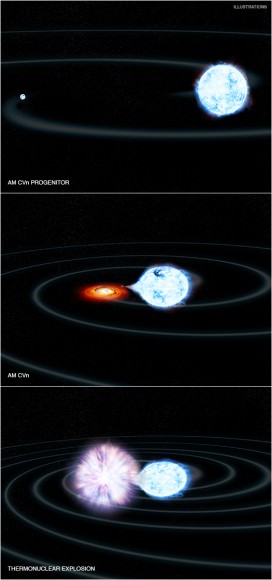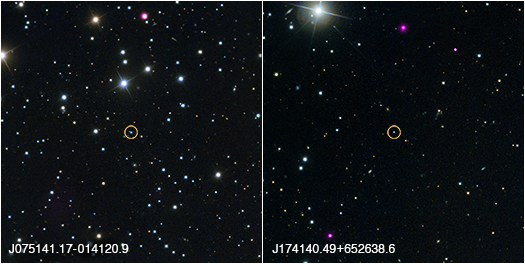For those of us who remain forever fascinated by astronomy, nothing could spark our imaginations more than a cosmic curiosity. In this case, the unusual object is a star cataloged as AM Canum Venaticorum (AM CVn) located in the constellation of Canes Venatici. What makes this dual star system of interest? Try the fact that the pair revolve completely around each other in a brief 18 minutes. What’s more, they are the stuff of which Einstein dreamed… creators of ripples in space-time known as gravitational waves.
Like other astronomical anomalies, AM CVn became the forerunner of a new class of stellar objects. It is a white dwarf, a sun-like star which has exhausted its fuel and collapsed to around the size of Earth. Yet it also has a white dwarf companion – a very compact orb which is delivering matter to its neighbor. AM Canum Venaticorum is not alone, however. There are similar systems where the stellar pairs complete their rotations in about an hour and even as rapidly as five minutes! Can you imagine the crackling amount of energy a system like this produces?!
Even though we have been aware of systems like AM CVn for almost five decades, no one is quite sure how they originate. Now, through the use of X-ray and optical observations, astronomers are taking a look at newly evolved double stars systems which one day might become a dueling duo dwarf. Heading their list are two binary systems, J0751 and J1741. These candidates were observed in the X-ray part of the electromagnetic spectrum by NASA’s Chandra X-ray Observatory and ESA’s XMM-Newton telescope. In addition, observations at optical wavelengths were made using the McDonald Observatory’s 2.1-meter telescope in Texas, and the Mt. John Observatory 1.0-meter telescope in New Zealand.
 “The artist’s illustration depicts what these systems are like now and what may happen to them in the future. The top panel shows the current state of the binary that contains one white dwarf (on the right) with about one-fifth the mass of the Sun and another much heavier and more compact white dwarf about five or more times as massive (unlike Sun-like stars, heavier white dwarfs are smaller).” says the Chandra X-ray Observatory news release.
“The artist’s illustration depicts what these systems are like now and what may happen to them in the future. The top panel shows the current state of the binary that contains one white dwarf (on the right) with about one-fifth the mass of the Sun and another much heavier and more compact white dwarf about five or more times as massive (unlike Sun-like stars, heavier white dwarfs are smaller).” says the Chandra X-ray Observatory news release.
What’s happening here? As the pair of white dwarf stars whip around each other, they are releasing gravitational waves which constrict the orbit. In time, the heavier, diminutive dwarf will begin stripping material from its lighter, larger companion (as seen in the middle panel). This material consumption will continue for perhaps a 100 million years, or until the collected matter reaches a critical mass and releases a thermonuclear explosion.
Another scenario is the thermonuclear explosion could annihilate the larger white dwarf completely in what astronomers call a Type Ia supernova. An event like this is well-known and gives a measurement in standard candles for cosmic distance. However, chances are better the explosion will happen on the surface of the star – an event known as .Ia supernovae. While .Ia supernovae events have been recorded in other galaxies, J0751 and J1741 are the first binary stars which have the potential to erupt in .Ia supernovae.
“The optical observations were critical in identifying the two white dwarfs in these systems and ascertaining their masses. The X-ray observations were needed to rule out the possibility that J0751 and J1741 contained neutron stars.” says the Chandra team. “A neutron star – which would disqualify it from being a possible parent to an AM CVn system – would give off strong X-ray emission due to its magnetic field and rapid rotation. Neither Chandra nor XMM-Newton detected any X-rays from these systems.”
Are AM CVn systems riding the gravitational wave? While astronomers haven’t been able to detect them yet, these new observations are highly important because equipment to verify their presences is currently being developed. It won’t be long until we can see the wave and have a whole new way of looking at the Universe!
Original Story Source: Chandra Observatory News Release.


OT, sorry!
What kind of christmas gift should I give to my best friends 3 years old to help her become an astronomer?
Personally I’d go for something like a pop up book (they still make those right?) Barring that I’d say anything age appropriate with a space theme. Duplo blocks, (they are the big Legos) or something Fisher Price would be good starting points.
Even images of space or an animated movie might help inspire. But I’m all for physically tangible and activating toys. She will grow up with images on flat touch screens…